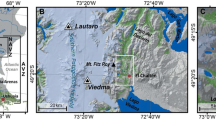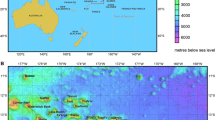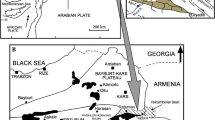Abstract
Lake Rotoiti in Taupo Volcanic Zone was formed by damming of the drainage system through the floor of Okataina Caldera. Basin sediments are predominantly silt or sand, with mineralogy consistent with derivation from local silicic rocks and airfall tephras. Sandy lithofacies around the shoreline are wave worked deposits. Sand and gravel lithofacies in deeper water and on steep slopes are largely relict or airfall tephras, or both. Profundal sediments are diatomaceous silts. Organic-rich diatomaceous silts also accumulate in near-shore wave-damped zones under weed beds.
Short cores penetrated the Tarawera (1886 AD) and Kaharoa (1180 AD) Tephras, identified by their stratigraphic position, geochemistry and mineralogy. Localised slumping is evidenced from secondary tephras interbedded and redeposited within the basin silts. Sedimentation rates in the basins, estimated from the age of bounding tephras, are 0.9 to 4.0 mm y-1, and are highest under the influence of inflowing water from adjacent Lake Rotorua. For several hundred years prior to the Tarawera eruption sediment accumulation rates and the sediment geochemistry remained unchanged; deposition was predominantly biogenic opaline silica with a small terrestrial component. The Tarawera eruption deposited a terrestrial-silica, aluminum-rich primary tephra across the lake, which was followed by reworked tephra from within the catchment, the effects of which were progressively diluted by biogenic opaline silica as conditions stabilised. While the major effects of the eruption have been rapidly absorbed the lake has not returned to pre-eruption background conditions. A new equilibrium has been attained in which Tarawera Tephra continues to be eroded into the lake and is the principal source for a doubling of sedimentation rates following the eruption. High arsenic levels in some diatomaceous silts are attributed to episodic venting of hydrothermal fluids or gases into the water column.
Similar content being viewed by others
References
Bohrmann, G., 1988. Zur Sedimentationsgeschihte von biogenen Opal im nordlichen Nordatlantik und dem Europaischen Nordmeer (DSDP/ODP-Bohrungen 408, 642, 643, 644, 646 und 647) Berichte aus dem Sonderforschungsbereich 313, University of Kiel, 9, 221 p.
Calhaem, I. M., 1973. Heat flow measurements under some lakes in the North Island, New Zealand. PhD thesis, Victoria University Wellington, 191 p.
CarrJ. L., 1966. Freshwater phytoplankton and phytonekton from Lake Rotoiti. Tane 12: 13–36.
CassieV., 1974. Algal flora of some North Island, New Zealand lakes, including Rotorua and Rotoiti. Pacif. Sci. 28: 467–504.
ChapmanV. J., J. M. A.Brown, F. I.Droomgoole & B. T.Coffey, 1971a. Submerged vegetation of the Rotorua and Waikato lakes 1: Lake Rotoiti. N. Z. Jl mar. Freshwat. Res. 5: 259–279.
ChapmanV. J., B. T.Coffey & J. M. A.Brown, 1971b. Submerged vegetation of the Rotorua and Waikato lakes 2: ‘Cyclic change’ in Lake Rotoiti. N. Z. Jl mar. Freshwat. Res. 5: 461–482.
ColeJ. W., 1970a. Description and correlation of Holocene volcanic formations in the Tarawera-Rerewhakaaitu region. Trans. R. Soc. N. Z., Earth Sci. 8: 92–108.
ColeJ. W., 1970b. Structure and eruptive history of the Tarawera volcanic complex. N. Z. Jl Geol. Geophys. 13: 879–902.
ColeJ. W., 1979a. Structure, petrology, and genesis of Cenozoic volcanism, Taupo Volcanic Zone, New Zealand—a review. N. Z. Jl Geol. Geophys. 22: 631–657.
Cole, J. W., 1979b. Chemical analyses of lavas and ignimbrites of the Taupo Volcanic Zone. Geology Department Victoria University Wellington. Publication 13.
Craig, G. G. P., 1985. Bottom sediments of Lake Rotoiti, central North Island, New Zealand. Unpublished MSc thesis, University of Waikato, Hamilton, New Zealand.
Devcich, A. A., 1979. Ecology of freshwater crayfish. Unpublished D. Phil. thesis, University of Waikato, Hamilton, New Zealand.
FishG. R., 1979. Recent stratigraphy of sediments in Lake Rotorua. N. Z. Jl Geol. Geophys. 13: 529–532.
FolkR. L. & W. C.Ward, 1957: Brazos River bar: a study in the significance of grain size. J. sedim. Petrol. 27: 3–26.
FroggattP. C. & D. J.Lowe, 1990. A review of late Quaternary silicic and some other tephra formations from New Zealand: their stratigraphy, distribution, volume, and age. N. Z. Jl Geol. Geophys. 33: 89–109.
HakånsonL., 1977. The influence of wind, fetch, and water depth on the distribution of sediments in Lake Vanern, Sweden. Can. J. Earth Sci. 14: 397–412.
HealyJ., 1975. Volcanic Lakes. Pp 70–83 in JollyV. H., and BrownJ. M. A. (ed.), New Zealand Lakes. Oxford University Press, Auckland.
HealyJ., J. C.Schofield & B. N.Thompson, 1964. Sheet 5 Rotorua (1st ed). Geological map of New Zealand 1: 25000. DSIR, Wellington.
Hedenquist, J. W., 1986. Geothermal systems in the Taupo Volcanic Zone: Their characteristics and relation to volcanism and mineralisation. Pp 134–168 in Smith I. E. M. (Ed) Late Cenozoic Volcanism in New Zealand. Bulletin of the Royal Society of New Zealand. 23.
Holler, P. & R. A. Pickrill, In prep. Lake Rotoiti New Zealand: Physical properties of sediments and origin of shallow seismic reflectors.
Hume, T. M. & C. S. Nelson, 1982. X-ray diffraction analytical procedures and some mineralogical characteristics for South Auckland region sediments and sedimentary rocks with special reference to their clay fraction. University of Waikato, Department of Earth Sciences, Occasional Report 10. 33 p.
Irwin, J. & W. de L. Main, 1982. Lake Rotoiti Bathymetry 1: 15000 (2nd Ed.) N. Z. Oceanographic Institute chart, Lake series.
LewisD. W., 1981. Practical Sedimentology. Apteryx Books, Christchurch.
Lowe, D. J. & J. D. Green, 1987. Origin and development of the lakes. pp 1–64 in Viner. A. B., (ed) Inland Waters of New Zealand. N. Z. DSIR Bulletin 241, Wellington.
Lowe, D. J. & C. S. Nelson, 1983. Guide to the nature and methods of analysis of the clay fraction of tephras from the South Auckland region, New Zealand. University of Waikato, Department of Earth Sciences, Occasional Report 11, 69 p.
KennedyN. M., W. A.Pullar & C. F.Pain, 1978. Late Quaternary land surfaces and geomorphic changes in the Rotorua Basin, North Island, New Zealand. N. Z. Jl Sci. 21: 249–264.
McCollR. H. S., 1975. Chemical and biological conditions in lakes of the Volcanic Plateau. Pp 124–139 in JollyV. H. & J. M. A.Brown, (ed.), New Zealand Lakes. Oxford University Press, Auckland.
McGloneM. S., 1983. Holocene pollen diagrams, Lake Rotorua, North Island, New Zealand. Jl R. Soc. N. Z. 13: 53–65.
NairnI. A., 1979. Rotomahana-Waimangu eruption, 1886: base surge and basalt magma. N. Z. Jl Geol. & Geophys. 22: 363–378.
Nairn, I. A., 1981. Some studies of the geology, volcanic history, and geothermal resources of the Okataina Volcanic Centre, Taupo Volcanic Zone, New Zealand. Unpublished PhD thesis, Victoria University of Wellington, Wellington, New Zealand.
NelsonC. S., 1983. Bottom sediments of Lake Rotoma. N. Z. Jl mar. Freshwat. Res. 17: 185–204.
Pickrill, R. A., In prep. Shallow seismic stratigraphy of a hydrothermally influenced lake, Lake Rotoiti New Zealand.
PriscuJ. C., R. H.Spiegel, M. M.Gibbs & M. T.Downes, 1986. A numerical analysis of hypolimnetic nitrogen and phosphorus transformations in Lake Rotoiti, New Zealand: A geothermally influenced lake. Limnol. Oceanogr. 31: 812–831.
Pullar, W. A., 1973. Age and distribution of late Quaternary pyroclastic and associated cover deposits of the Rotorua and Taupo area, North Island, New Zealand. New Zealand Soil Survey Report 1.
VincentW. F., M. M.Gibbs & S. J.Dryden, 1984. Accelerated eutrophication in a New Zealand lake: Lake Rotoiti, central North Island. N. Z. Jl mar. Freshwat. Res. 18: 431–440.
VincentW. F., R. H.Spiegel, M. M.Gibbs, G. W.Payne, S. J.Dryden, M. J.May, S.Pickmere, J.Davies & B.Shakespeare, 1986. The impact of the Ohau channel outflow from Lake Rotorua on Lake Rotoiti. Taupo Research Laboratory, Division of Marine and Freshwater Science, DSIR, Taupo, New Zealand, File Report 9.
WilsonC. J. N., A. M.Rogan & I. E. M.Smith, 1984. Caldera volcanos of the Taupo Volcanic Zone, New Zealand. Jl. Geophys. Res. 89 B 10: 8463–8484.
Author information
Authors and Affiliations
Rights and permissions
About this article
Cite this article
Pickrill, R.A., Nelson, C.S., Stoffers, P. et al. Influence of late holocene pyroclastic eruptions on the sedimentary geochemistry of Lake Rotoiti, North Island, New Zealand. J Paleolimnol 6, 173–192 (1991). https://doi.org/10.1007/BF00233070
Received:
Accepted:
Issue Date:
DOI: https://doi.org/10.1007/BF00233070




